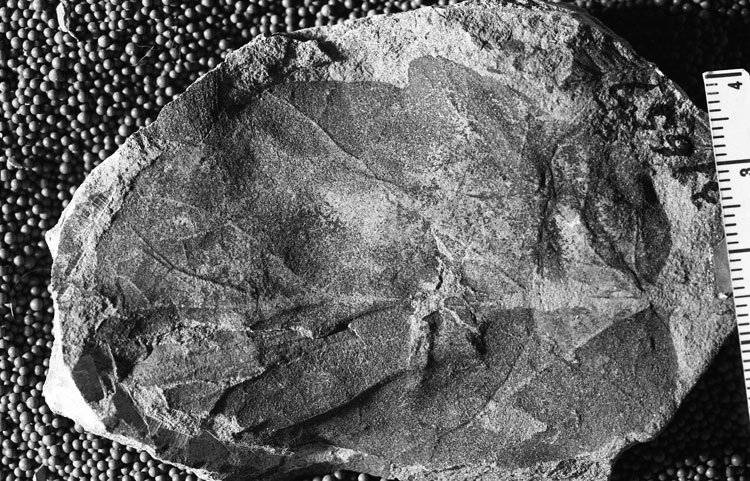Locality
From Hollick (1930) (p. 108-109)
"Port Moller, 2 miles up the canyon, west from Mud Bay, Alaska Peninsula (original No. 35),
collected by W. W. Atwood and H. M. Eakin in 1908 (lot 5187)."
Description
From Hollick (1930) (p. 108-109)
"Leaf oblong, inequilateral, 6 centimeters in length by 4.5 centimeters in width, rounded above to a blunt apex and below to an oblique truncate-cordate base; margin irregularly wavy, with one broad, blunt tooth below the middle on the broader side; midrib somewhat flexuous; nervation craspedo-camptodrome; secondary nerves craspedodrome to the marginal inequalities, pinnately arranged, the lowest two opposite, arising from the base, with fine branches on the under sides that thin out and coalesce or disappear along the margin, the basilar branch on each side simulating a lateral basilar veinlet; upper secondaries subopposite, three on each side, those on the broader side diverging from the midrib at more obtuse angles than those opposite, all irregularly branched or forked toward the extremities on both under and upper sides."
Remarks
From Hollick (1930) (p. 108-109)
"This leaf is referred to the living genus Pterospermum instead of to the fossil genus Pterospermites for the reason that it appears to resemble the former more closely than it does the latter as originally defined. Pterospermites vagans Heer (1859) (p. 36, pl. 109, figs. 1 - 5) the type of the genus, was founded on fossil seeds, while Pterospermites integrifolius Heer (1868) (p. 122, pl. 9, fig. 14a) and P. dentatus Heer (1868) (p. 138, pl. 21, fig. 15b; pl. 23, figs. 6, 7 (8, 9?)) the first fossil leaves that were referred by the author to the genus are, respectively, subpeltate and peltate. This feature may therefore be regarded as a generic character; although subsequently a number of species of nonpeltate leaves were included in the genus by Heer and other writers.
Our specimen is nonpeltate and resembles the figure of Pterospermum sp. by Ettingshausen (1861) (pl. 49, fig. 6) more closely than it resembles any of the peltate forms of Pterospermites; although it apparently belongs with the nonpeltate type of leaves represented by Pterospermites modestus Lesquereux (1892) (p. 186, pl.58, fig. 5) and P. longiacuminatus Lesquereux (1892) (pl. 59, fig. 3) from the Dakota sandstone of Kansas. In any critical revision of the genus the species of the type of those last mentioned might better be excluded and referred to some one or another allied genus, such as Pterospermum or Sterculia."
